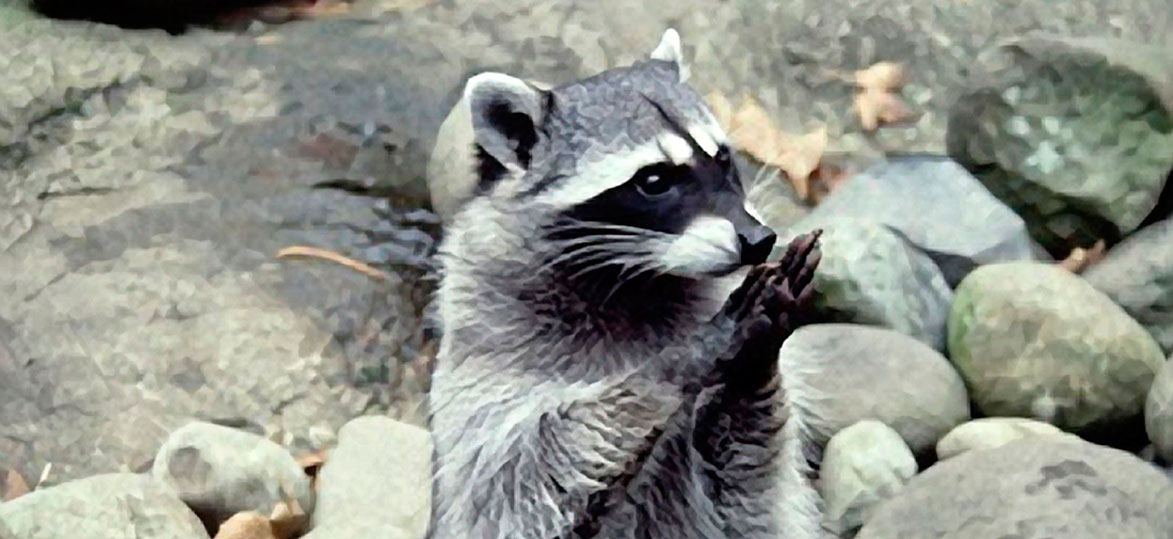
The raccoon (Procyon lotor) is one of the most common medium-sized mammals in North America. Originally, the raccoon occupied habitats in hardwood forests with close proximity to a water source. Today, the raccoon is found in a wide variety of habitats and is commonly found in suburban and urban environments.
This adaptability has led to an increase in the raccoon population, which has created conflicts between people and raccoons. The spread of rabies is a serious concern in the northeast, which increases the chance of its transmission to humans.
As a furbearer, the raccoon is trapped for its coat. Trapping and hunting help manage its population to control the spread of diseases.
Habitat
Raccoons were originally animals of the forest. However, since European colonization, raccoons have become common everywhere. Today, raccoons are found in almost any area that has access to water. They can most often be seen along streams, in open forests, or wetlands but inhabit urban, suburban and farming areas as well.
Raccoons live in hollow trees, ground dens, brush or rubbish piles, lumberyards, haylofts, attics and chimneys. They use a variety of sites for rearing their young as well as for wintering dens.
Raccoons are nocturnal. Like the rest of their habits, they often modify their behavior when searching for food or water. Raccoons are curious animals, which, at times, can cause problems with humans. This has led to some people labeling them as mischievous and as bandits or robbers.
Raccoons are solitary and are seldom seen together unless in a family unit. In winter, raccoons do not hibernate but do sleep more than during summer. During extremely cold weather, raccoons occasionally den together to conserve body heat but will part once the temperature rises.
Raccoons are very intelligent and are known for their ability to outwit human and animal predators alike. Raccoons are excellent climbers and swimmers, which allow them a variety of escape routes. They have keen eyesight and a heightened sense of hearing. They can also be very aggressive, which aids in their ability to escape predation.
Reproduction
The raccoon breeds from January to mid-March. After mating, the female will find a suitable den site, generally the cavity of a tree such as a maple or beech. However, if a cavity is not readily available, she may find an alternative den, such as a burrow, to give birth to her young.
After a gestation period of 60 to 73 days, the litter is born in late April or May. The young, typically numbering four to five but sometimes as many as eight, are helpless and completely dependent on their mother for survival. The male raccoon plays no role in raising the young. The female is very protective of her young and will carry them around by the nape of the neck, as would a mother cat with her kittens
The young develop quickly. They are able to open their eyes after 18 days and soon after gain the ability to hear. By the time they are four to six weeks old, they are strong enough to stand on their own. They are weaned from their mother's milk and begin to hunt independently by the time they are about three months old.
The young will remain with their mother for one year, by which time the young female will reach sexual maturity. A young male raccoon does not reach sexual maturity until it is two years of age. A raccoon has one litter a year.
Diet
Raccoons are omnivores, which mean they eat both plants and animals. However, a better term may be optivoires, as the raccoons are opportunistic and will eat whatever is readily available. Examples of wild food items include waterfowl, birds, mammals, insects, crayfish, wild grains, fruit, and carrion (dead animals).
Raccoons will also take human food sources including poultry, eggs, and garbage. This varied diet has led to an increase in the raccoon population, which is the source of the conflict with humans.
The raccoon is well known for its tendency to "wash" its food before eating it. Although it appears to be washing the object, it is believed that it is actually inspecting it for any portions that should be rejected. A raccoon's sense of touch is enhanced when its paws are wet and by feel, it will tear and discard any unwanted portions of food. The raccoon only performs this ritual if water is close by. If no water is available, then it will simply eat its food without further inspection.
Management
The fur of raccoons can be used to produce items ranging from coats to hats. In certain parts of the United States, the raccoon is also hunted for food. Presently, the spread of rabies throughout the raccoon population has brought added concerns in terms of hunting and trapping.
Hunters and trappers should be very careful when handling animals, as the virus can be spread to humans. Hunting and trapping seasons allow for control of the raccoon population and will slow the spread and occurrence of diseases like rabies.
An experimental rabies vaccine is being field tested in Vermont to slow the spread of rabies. If you see a raccoon acting strange in any way, stay away from it and contact your local game warden by calling the nearest State Police Office.
Status
Raccoons are common throughout their range and preferred habitat. They can be found throughout Vermont, but are more common in mixed woodlands or agricultural fields are near water. They are extremely adaptable to human influence and can be found in both urban and rural areas.
